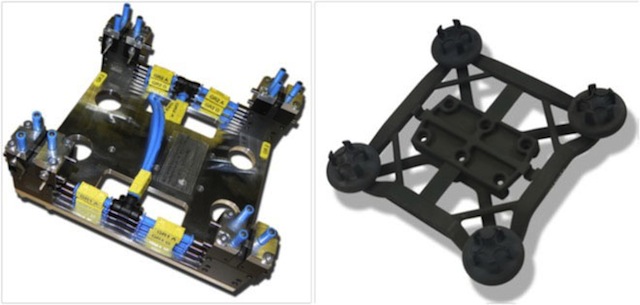Ball bearing grippers — used prolifically in many different types of industrial special-purpose machinery — are one of those products that are easily overlooked, and, let’s be honest, do not generally elicit excitement. However, at Euromold recently, I was looking at a new generation of gripper that did get me excited because it has proved to be a fantastic example of how 3D printing can make things better — figuratively and literally!
A fully functioning four-fold ball bearing gripper, working relentlessly on a Wittman machine, was a highlight of the large EOS stand as part of a complete additive manufacturing process solution that was demonstrated at the show. The four-fold ball bearing gripper was conceived in cooperation with Kuhnstoff and Wittmann as an optimized design that was produced on an EOS laser sintering 3D printer.
Peter Klink, EVP Sales at EOS was on hand at the show and explained how this project came about: “We are increasingly receiving enquiries from renowned OEMs that are looking into working with our technology. We support them with identifying the right applications for use of additive manufacturing, optimizing these applications and integrating this manufacturing process in to their own process chains.”
Furthermore, special-purpose machinery manufacture provides incentives for numerous other industries and issues. For example, energy/resource efficiency and an increase in productivity are often top priorities for many companies.
The gripper application is just one example of how EOS technology addresses these issues.
Essentially the four-fold ball bearing gripper highlights the three decisive advantages of 3D printing — optimization, economic efficiency and profitability. Optimisation is achieved through functional integration, which led to a considerable reduction in the number of components and thus assembly, not to mention a product that weighs 7x less than a traditionally manufactured equivalent product. The optimization was made possible by 3D printing, and more specifically the laser sintering process, because quite simply the optimized design could not be materialized in any other way. Economic efficiencies and therefore profitability come from a design that costs 2/3 of the price of a traditional model to manufacture but also in terms of reducing stocklists and easier handling. Furthermore, this optimized product is able to protect the tool during a crash or malfunction of the machine.
Quick Comparison:
Traditional Gripper 3D Printed Gripper
Weight: 1542 g 215 g
Cost: €2670 €1700
Total height: 87.5 mm 30 mm from C-Swivel

In addition to the figures above, Peter Klink concluded with the great customization of 3D printing, “Since production is direct from 3D CAD data, special wishes expressed by the end user of the machinery can be implemented tailor made, faster and at significantly lower production costs.”


